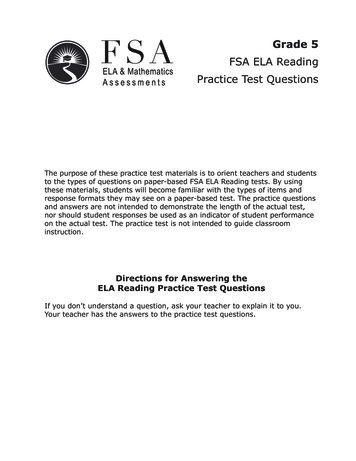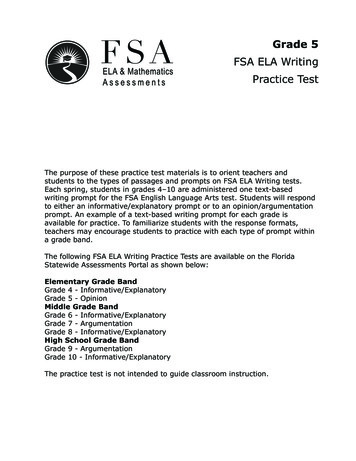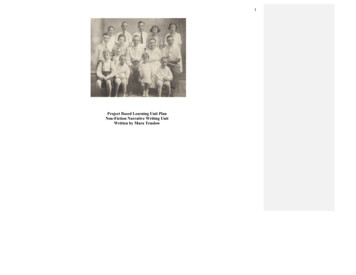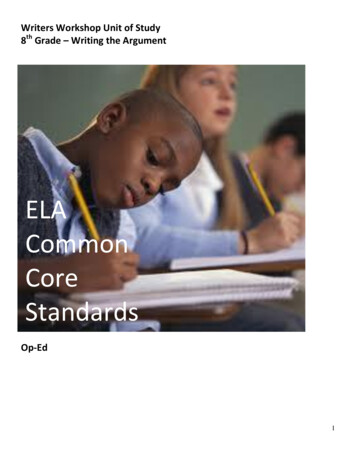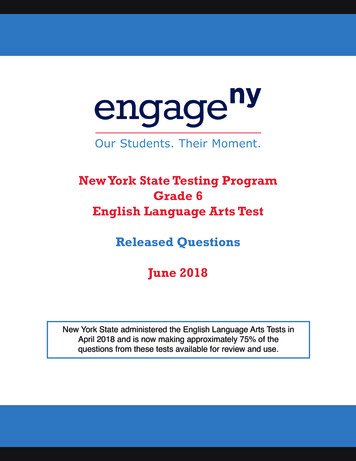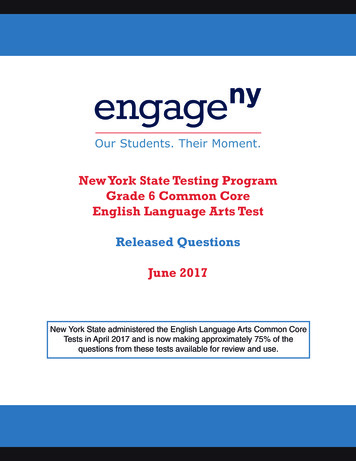
Transcription
New York State Testing ProgramGrade 6 Common CoreEnglish Language Arts TestReleased QuestionsJune 2017New York State administered the English Language Arts Common CoreTests in April 2017 and is now making approximately 75% of thequestions from these tests available for review and use.
THESTATEEDUCATION DEPARTMENT / THE UNIVERSITY OF THE STATEOF NEW YORK/ ALBANY, NY 12234New York State Testing ProgramGrades 3–8 English Language ArtsReleased Questions from 2017 ExamsBackgroundIn 2013, New York State began administering tests designed to assess student performance in accordancewith the instructional shifts and rigor demanded by the new New York State P-12 Learning Standards inEnglish Language Arts (ELA). To help in this transition to new assessments, the New York State EducationDepartment (SED) has been releasing an increasing number of test questions from the tests that wereadministered to students across the State in the spring. This year, SED is again releasing large portions ofthe 2017 NYS Grades 3–8 Common Core English Language Arts and Mathematics test materials for review,discussion, and use.For 2017, included in these released materials are at least 75 percent of the test questions that appearedon the 2017 tests (including all constructed-response questions) that counted toward students’ scores.Additionally, SED is providing information about the released passages; the associated text complexity foreach passage; and a map that details what learning standards each released question measures and thecorrect response to each question. These released materials will help students, families, educators, andthe public better understand the tests and the New York State Education Department’s expectations forstudents.Understanding ELA QuestionsMultiple-Choice QuestionsMultiple-choice questions are designed to assess the New York State P-12 Learning Standards in EnglishLanguage Arts. These questions ask students to analyze different aspects of a given text, including centralidea, style elements, character and plot development, and vocabulary. Almost all questions, includingvocabulary questions, will be answered correctly only if the student comprehends and makes use of thewhole passage.For multiple-choice questions, students select the correct response from four answer choices. Multiplechoice questions assess reading standards in a variety of ways. Some ask students to analyze aspects oftext or vocabulary. Many questions require students to combine skills. For example, questions may askstudents to identify a segment of text that best supports the central idea. To answer these questionscorrectly, a student must first comprehend the central idea and then show understanding of how thatidea is supported. Questions tend to require more than rote recall or identification.Short-Response QuestionsShort-response questions are designed to assess New York State P-12 Reading and Language Standards.These are single questions in which a student uses textual evidence to support his or her answer to aninferential question. These questions ask the student to make an inference (a claim, position, or
conclusion) based on his or her analysis of the passage, and then provide two pieces of text-basedevidence to support his or her answer.The purpose of the short-response questions is to assess a student’s ability to comprehend and analyzetext. In responding to these questions, students are expected to write in complete sentences. Responsesrequire no more than three complete sentences. The rubric used for evaluating short-response questionscan be found in the grade-level Educator Guides at sh-language-arts-and-mathematics.Extended-Response QuestionsExtended-response questions are designed to measure a student’s ability to write from sources.Questions that measure Writing from Sources prompt students to communicate a clear and coherentanalysis of one or two texts. The comprehension and analysis required by each extended response isdirectly related to grade-specific reading standards. Student responses are evaluated on the degree towhich they meet grade-level writing and language expectations. This evaluation is made by using a rubricthat incorporates the demands of grade-specific New York State P-12 Reading and Language standards.The integrated nature of the standards for ELA and literacy requires that students are evaluated acrossthe strands (Reading, Writing, and Language) with longer pieces of writing, such as those prompted by theextended-response questions. The rubric used for evaluating extended-response questions can be foundin the grade-level Educator Guides at ish-languagearts-and-mathematics.New York State P-12 Learning Standards AlignmentThe alignment(s) to the New York State P-12 Learning Standards for English Language Arts is/are intendedto identify the analytic skills necessary to successfully answer each question. However, some questionsmeasure proficiencies described in multiple standards, including writing and additional reading andlanguage standards. For example, two-point and four-point constructed-response questions requirestudents to first conduct the analyses described in the mapped standard and then produce writtenresponses that are rated based on writing standards. To gain greater insight into the measurement focusfor constructed-response questions, please refer to the rubrics.These Released Questions Do Not Comprise a “Mini Test”To ensure future valid and reliable tests, some content must remain secure for possible use on futureexams. As such, this document is not intended to be representative of the entire test, to show howoperational tests look, or to provide information about how teachers should administer the test; rather,its purpose is to provide an overview of how the test reflects the demands of the New York State P-12Learning Standards.The released questions do not represent the full spectrum of the standards assessed on the State tests,nor do they represent the full spectrum of how the standards should be taught and assessed in theclassroom. It should not be assumed that a particular standard will be measured by an identical questionin future assessments. Specific criteria for writing test questions, as well as additional assessmentinformation, are available at http://www.engageny.org/common-core-assessments.
2017 Grade 6 ELA Test Text Complexity Metrics forReleased Questions Available on EngageNYSelecting high-quality, grade-appropriate passages requires both objective textcomplexity metrics and expert judgment. For the Grades 3–8 assessments based on theNew York State P-12 Learning Standards for English Language Arts, both quantitativeand qualitative rubrics are used to determine the complexity of the texts and theirappropriate placement within a grade-level ELA exam.Quantitative measures of text complexity are used to measure aspects of textcomplexity that are difficult for a human reader to evaluate when examining a text.These aspects include word frequency, word length, sentence length, and text cohesion.These aspects are efficiently measured by computer programs. While quantitative textcomplexity metrics are a helpful start, they are not definitive.Qualitative measures are a crucial complement to quantitative measures. Usingqualitative measures of text complexity involves making an informed decision about thedifficulty of a text in terms of one or more factors discernible to a human readerapplying trained judgment to the task. To qualitatively determine the complexity of atext, educators use a rubric composed of five factors; four of these factors are requiredand one factor is optional. The required criteria are: meaning, text structure, languagefeatures, and knowledge demands. The optional factor, graphics, is used only if agraphic appears in the text.To make the final determination as to whether a text is at grade-level and thusappropriate to be included on a Grades 3–8 assessment, New York State uses a two-stepreview process, which is an industry best-practice. First, all prospective passagesundergo quantitative text complexity analysis using three text complexity measures. Ifat least two of the three measures suggest that the passage is grade-appropriate, thepassage then moves to the second step, which is the qualitative review using the textcomplexity rubrics. Only passages that are determined appropriate by at least two ofthree quantitative measures of complexity and are determined appropriate by thequalitative measure of complexity are deemed appropriate for use on the exam.For more information about text selection, complexity, and the review process pleaserefer lexity-grades-9-12
Degrees ofReading Power*Flesch-KincaidDrawing HorsesExcerpt from The Black PearlMove Over, Spider-Man--Here's SpiderGoat!Excerpt from Interference Powder"Ideas That Work . . . and Those ThatDon’t" from When is a Planet Not aPlanet? The Story of PlutoBuilding for "Pests": Critters Need Houses,TooExcerpt from The Mozart QuestionExcerpt from Leonardo da Vinci:Renaissance GeniusExcerpt from Leonardo da Vinci for Kids:His Life and IdeasWordCount750868849LexilePassage TitleReading MaturityMetric*Text Complexity Metrics for 2017 Grade 6 riate679930L7.359Appropriate* Depending on when the passage was selected, either the Reading Maturity Metric or Degrees of Reading Power wasused as the third quantitative metric.New York State 2017 Quantitative Text Complexity Chart for Assessment and CurriculumTo determine if a text’s quantitative complexity is at the appropriate grade level, NewYork State uses the table below. In cases where a text is excerpted from a large work,only the complexity of the excerpt that students see on the test is measured, not thelarge work, so it is possible that the complexity of a book might be above or below gradelevel, but the text used on the assessment is at grade level. Because the measurementof text complexity is inexact, quantitative measures of complexity are defined by gradeband rather than by individual grade level and then paired with the qualitative review byan �10th11th–12thATOS2.75 – 5.144.97 – 7.037.00 – 9.989.67 – 12.0111.20 – 14.10Degrees ofReadingPower42 – 5452 – 6057 – 6762 – 7267 – 74Source: Student Achievement PartnersFlesch-Kincaid1.98 – 5.344.51 – 7.736.51 – 10.348.32 – 12.1210.34 – 14.20The LexileFramework420 – 820740 – 1010925 – 11851050 – 13351185 – 1385ReadingMaturity3.53 – 6.135.42 – 7.927.04 – 9.578.41 – 10.819.57 – 12.00SourceRater0.05 – 2.480.84 – 5.754.11 – 10.669.02 – 13.9312.30 – 14.50
“Drawing Horses” by Cerelle Woods. From Highlights for Children, Inc. April 2000, Vol. 55. Used by permission.Excerpt from “The Black Pearl” by Scott O’Dell. Houghton Mifflin Company, 1967. Used by permission.“Move Over, Spider‑Man–Here’s Spider‑Goat!” by Joli Allen. From Spider Magazine, August 2005, Vol. 12, No. 8.Used by permission.Developed and published under contract with the New York State Education Department by Questar Assessment Inc., 5550 Upper 147thStreet West, Minneapolis, MN 55124. Copyright 2017 by the New York State Education Department.Book 1
Book 1TIPS FOR TAKING THE TESTHere are some suggestions to help you do your best: Be sure to read all the directions carefully. Most questions will make sense only when you read the whole passage. You may readthe passage more than once to answer a question. When a question includes a quotationfrom a passage, be sure to keep in mind what you learned from reading the wholepassage. You may need to review both the quotation and the passage in order to answerthe question correctly. Read each question carefully and think about the answer before choosing your response.Book 1Page 1
Read this story. Then answer questions 8 through 14.Drawing Horsesby Cerelle WoodsI’d give anything to draw horses the way Euphemia Tucker does. She draws them inthe margins of spelling tests and on the back of her math homework. They’re alwaysrunning wild and free, their manes swirling over the paper like clouds across the sky.5101520Euphemia’s horses look so real you can almostfeel their breath on your face.Luke Anderson, who sits next to me, says hecan’t decide whether my horses look more likeGreat Danes or kitchen tables. He also calls meMessy. I prefer Marisa, which is my real name, toMissy, which is what everyone—except Luke—callsme. If I could draw like Euphemia, I’d sign all mypictures Marisa. Nobody messes with Euphemia’sname, not even Luke Anderson.Today I sharpened my pencil and took a clean sheet of paper out of my desk. Then Iclosed my eyes and pictured one of Euphemia’s perfect horses rearing up and pawing theair with its sharp hooves. I could see it so clearly I was sure I’d be able to draw it this time.I started with what I do best: a big, billowing mane. Next I roughed in most of thebody and drew a long tail streaming out behind. It really wasn’t turning out half bad untilI got to the front‑legs‑pawing‑the‑air part, which looked more like two macaroni noodleswith tiny marshmallows for hooves.I tried again, but the hooves still didn’t seem right, and rather than doing them overand over, I erased them and went on to the head. That was when I really ran into trouble.25First I drew some great donkey ears, followed by sheep ears, pig ears, kangarooears . . . everything except horse ears. I erased again and again until I had rubbed a hole inthe paper. That was when Luke Anderson poked his nose over my shoulder.I scratched a big X through my earless, macaroni‑legged horse, wadded it up into alittle ball, and stuffed it under the lid of my desk.30I was still upset when I got off the school bus this afternoon. I walked past theneighbors’ horses standing in the field next to our house. They’ve been in that field for aslong as I can remember. Their stringy manes never float into the sky. Their ragged oldtails hang straight down to the ground, and I’ve never seen them run.GO ONPage 8Book 1
35I brooded about it all through dinner. After I’d helped clear the dishes, I sat down witha stack of typing paper and a freshly sharpened pencil. Without Luke Anderson there topester me, I hoped I’d have better luck. I practiced a few horses’ heads, trying to get theears right. Nothing worked.I tossed all the sketches into the trash and walked outside. The sun had just sunkbelow the horizon, feathering the whole sky with pink and orange wisps. Everythinglooked special in that light, even the scraggly horses next door.4045I dragged a lawn chair over to the fence and satdown to take a better look at them. They’d never befree spirits like Euphemia’s horses, but they did seempatient and strong. I noticed the curves of theirmuscles, the shadows on their faces, the shine alongtheir backs. Their colors reminded me of dessert—rich chocolate, deep cinnamon, creamy caramel.I was just sitting there, feeling kind of dazzled bythe unexpected beauty of it all, when I rememberedthe big box of pastels my grandmother had sent.50An idea began to take shape in my mind, and just then the cinnamon horse turned itshead toward me and nodded three times. It was like a sign.I hurried into the house, grabbed the pastels and some paper, and raced for the door.I choose a deep brown, pulling it across my paper in the shape of the chocolate horse.It comes out right the first time, even the legs and ears! Drawing horses is easier whenthey’re right in front of you, and I’ll say this for the ones next door—they hold their poses.55The sky is turning out just as I’d hoped, too; all the pinks and reds blending togetherlike a strawberry parfait, and I love the way the caramel horse’s mane is blowing, justbarely, in the wind.It doesn’t look exactly like one of Euphemia’s horses, of course. But I already knowthat when this drawing is finished, I’ll be signing it Marisa.GO ONBook 1Page 9
8In line 3, what does the simile “like clouds across the sky” help the reader understand aboutthe horses in Euphemia’s sketches?A They are drawn sloppily.B They look like they are in motion.C They are getting tangled up with each other.D They look like they are trotting through fog.9How do lines 14 through 16 contribute to the development of the plot?A They establish Marisa’s problem.B They emphasize Marisa’s hopefulness.C They contrast Marisa’s artistic abilities with Euphemia’s.D They illustrate Marisa’s determination to not let Luke bother her.10Which phrase best conveys the tone in lines 1 through 30?A “They’re always running wild and free. . .” (lines 2 and 3)B “He also calls me Messy.” (lines 8 and 9)C “Next I roughed in most of the body. . .” (lines 17 and 18)D “I scratched a big X through my earless, macaroni‑legged horse, . . .” (line 26)GO ONPage 10Book 1
11Read this sentence from line 32.I brooded about it all through dinner.What effect does the word “brooded” have in the story?A It shows Marisa’s anxiety about her abilities.B It reveals Marisa’s motives for drawing.C It emphasizes how Marisa is growing as a character.D It indicates Marisa has a major decision to make.12How do lines 36 through 38 help convey the theme of the story?A They show that some situations take time to change.B They prove that practice can help natural talents to develop.C They suggest that inspiration may come in unexpected ways.D They demonstrate that new ideas will eventually be accepted.13Which sentence best explains why Marisa’s final horse drawing was different than herfirst tries?A “Everything looked special in that light, even the scraggly horses next door.”(lines 37 and 38)B “I noticed the curves of their muscles, the shadows on their faces, the shine along theirbacks.” (lines 42 through 44)C “An idea began to take shape in my mind, and just then the cinnamon horse turned itshead toward me and nodded three times.” (lines 49 and 50)D “I choose a deep brown, pulling it across my paper in the shape of the chocolate horse.”(line 52)GO ONBook 1Page 11
14How does Marisa change while watching her neighbors’ horses?A She realizes that Euphemia’s horses do not look realistic, so she decides to try to drawbetter pictures than her friend.B She decides to try a different way of drawing and is proud of her work.C She realizes she can never be an artist like Euphemia but wants to draw like her anyway.D She finally learns that drawing horses is easier with proper lighting and art supplies.GO ONPage 12Book 1
Read this story. Then answer questions 15 through 21.Excerpt from The Black Pearlby Scott O’DellI had put the seventh pearl on the scales and was carefully setting the small copperweights to make them come to a proper balance when I heard my father’s steps outsidethe office. My hand shook at the sound and one of the weights slipped from my fingers. Amoment later the heavy iron door swung open.5My father was a tall man with skin turned a deep bronze color from the glare of thesea. He was very strong. Once I saw him take two men who were fighting and grasp themby the backs of their necks and lift them off the ground and bump their heads together.He came across the room to where I sat at the desk on my high stool and glanced atthe ledger.10“You work with much rapidity,” he said. “Six pearls weighed and valued since I left thismorning.” He wiped his hands on the tail of his shirt and took a pearl from the tray. “Forthis one,” he said, “what is your notation?”“Round. Fair. Weight 3.5 carats,” I answered.He rolled the pearl around in the palm of his hand and then held it to the light.15“You call this one only fair?” he asked. “It is a gem for the king.”“For a poor king,” I said. After four months of working with my father I had learnedto speak my mind. “If you hold it closer to the light, you will see that it has a flaw, amuddy streak, about midway through.”20He turned the pearl in his hand. “With a little care the flaw can be peeled away,”he said.“That, sir, I doubt.”My father smiled and placed the pearl back in the tray. “I doubt it also,” he said andgave me a heavy pat on the back. “You are learning fast, Ramón. Soon you will know morethan I do.”25I took a long breath. This was not a good beginning for the request I wanted to make.It was not good at all, yet I must speak now, before my father left. In less than an hour thetide would turn and the fleet sail from the harbor.“Sir,” I began, “for a long time you have promised me that when I was sixteen I couldgo with you and learn how to dive for pearls. I would like to go today.”GO ONBook 1Page 13
30My father did not reply. He strode to the slit in the wall and peered out. From a shelfhe took a spyglass and held it to one eye. He then put the spyglass down and cupped hishands and shouted through the slit.“You, Ovando, leaning against the cask, send word to Martin, who leans against thetiller of the Santa Teresa, that there is much work to do and little time in which to do it.”3540My father waited, watching through the slit, until his message was sent forwardby Ovando.“If you go with the fleet,” he said, “then all the male members of the Salazar familywill be on the sea at once. What happens if a storm comes up and drowns the both of us?I will tell you. It is the end of Salazar and Son. It is the end of everything I haveworked for.”“The sea is calm, sir,” I answered.“These words prove you a true landsman. The sea is calm today, but what oftomorrow? Tomorrow it may stand on end under the lash of a chubasco.”1“It is still a week or two before the big wind comes.”45“What of the sharks? What of the devilfish that can wring your neck as if it were theneck of a chicken? And the giant mantas by the dozens, all of them the size of one of ourboats and twice as heavy? Tell me, what do you do with these?”“I have the knife that grandfather gave me.”My father laughed and the sound bounded through the room like the roar of a bull.50“Is it a very sharp knife?” he asked scornfully.“Yes, sir.”“Then with much luck you might cut off one of the eight arms of the devilfish, justbefore the other seven wrap around you and squeeze out your tongue and your life.”I took another breath and brought forth my best argument.55“If you allow me to go, sir, I shall stay on deck while the others dive. I shall be the onewho pulls up the basket and minds the ropes.”I watched my father’s face and saw that it had begun to soften.60“I can take the place of Goleta,” I said quickly, to follow up the advantage I had gained.“There is an apology to make, sir. At noon Goleta’s wife came to say that her husband issick and cannot sail. I forgot to tell you.”1chubasco: a strong stormGO ONPage 14Book 1
My father walked to the iron door and opened it. He looked at the sky and at theglossy leaves of the laurel trees that hung quiet on their branches. He closed the door andput the tray of pearls in the safe and turned the bolt.“Come,” he said.GO ONBook 1Page 15
15Read line 15 of the story.“You call this one only fair?” he asked. “It is a gem for the king.”What does this line suggest about the father?A He has not looked at the pearl as closely as Ramón has.B He does not think that Ramón is correct about the pearl.C He is testing Ramón’s confidence in judging the pearl’s value.D He is teaching Ramón about the pearl’s quality.16Which detail from the story best supports the idea that Ramón is becoming an expert atjudging pearls?A “ ‘For this one,’ he said, ‘what is your notation?’ ” (lines 11 and 12)B “ ‘For a poor king,’ I said.” (line 16)C “ ‘With a little care the flaw can be peeled away,’ he said.” (lines 19 and 20)D “I would like to go today.” (line 29)17Why is the father reluctant to bring Ramón on a pearl‑diving trip?A He is concerned for Ramón’s safety.B He needs Ramón to evaluate more pearls.C He thinks Ramón is still too young to sail.D He is unsure Ramón is ready to dive.GO ONPage 16Book 1
18In line 55, why does Ramón suggest that he will “stay on deck while the others dive”?A His father needs him to help with other jobs on the boat.B He realizes that his father will never actually let him go.C His father has convinced him that it is too dangerous.D He is trying to gradually change his father’s mind.19How does line 57 best contribute to the development of the story?A by signaling a turning pointB by providing a solution to the problemC by comparing the characters’ actionsD by introducing a new conflict20How does the father change during the story?A He becomes concerned about a diver’s health.B He begins to acknowledge Ramón’s maturity.C He becomes frustrated by Ramón’s persistence.D He stops worrying about his family business.GO ONBook 1Page 17
21The author develops Ramón’s point of view in the story mostly byA describing Ramón’s fear of pearl divingB including Ramón’s analysis of the pearlC describing how Ramón feels about his fatherD including dialogue between Ramón and his fatherGO ONPage 18Book 1
Read this article. Then answer questions 29 through 35.Move Over, Spider-Man—Here’s Spider-Goat!by Joli AllenMaking silk threads isn’t just for spiders anymore. A special type of goat is doing it,too. Nubian goats look and act like any other playful, floppy‑eared goats. But when theyaren’t playing, these goats are busy making spider silk.510152025Spider silk is absolutely amazing. It’s five times stronger than steel, but it’s also verylight and flexible. Because of this, scientists plan to use it to make some totally coolthings! Imagine clothing that’s as light as a cobweb, yet won’t tear, or fishing line andtennis racket strings that won’t break. Doctors might be able to use spider silk for makingtiny stitches in delicate eye surgery, but it could also be strong and flexible enough toreplace some worn‑out parts of the human body. The silk also could be used to buildairplanes, buildings, and bridges, as well as create a tough coating for space stations.Because of all these possibilities, scientists have been searching for ways to make spidersilk in huge quantities, and they have finally found the answer: Nubian goats!Scientists have studied spider silk for years. They tried to raise spiders on spider farmsto collect silk from them, but the spiders didn’t enjoy living so close to one another.Spiders like their own space, and when they don’t get it . . . well . . . they make space byeating their neighbors!Goats, the scientists discovered, are much friendlier than spiders and are also easierto work with. Because they’re bigger, a few goats can produce more silk than a roomful ofspiders. The scientists chose Nubian goats for this job because they make milk at ayounger age than many other goats. So, the Nubian goats will make spider silk sooner andfor longer periods of time.But how do the goats actually make the spider silk? That’s what scientist Jeffrey Turnerwanted to figure out when he taught animal science at McGill University in Montreal. Henoticed that the body parts of spiders that make silk and the parts of goats that make milkare very much alike. Because of this, he figured that goats might be able to make spidersilk. The idea excited him, and he started his own company in 1993 to do more researchon how goats could do what spiders have been doing for years.GO ONBook 1Page 25
303540455055Eventually, Turner and his fellow scientists found a way to place spider genes in goatsso that the genes fit nicely, like a guest in a comfortable hotel. Every living animal,including humans, has a set of genes inside of it that tells its body what to do. These genesare very, very tiny, but they hold lots of information on how to build parts of the body. Aspider’s genes contain instructions for making spider silk, and a goat’s genes containinstructions for making milk. So by putting spider genes into goats, the goats then havethe genes that tell their bodies how to make spider silk proteins.Proteins are the body’s basic building blocks. Just as people have proteins in theirbodies that make their hair, skin, and muscles, the goats now have special proteins formaking spider silk. When the goats produce milk, the spider silk proteins are in it, but itlooks just like regular milk. Scientists separate the proteins out of the milk by skimmingoff the fat and then sprinkling salt on it. The salt makes the spider silk proteins curdle intosmall clumps. These clumps are scooped out, and water is added until the mixture has thethickness of maple syrup. This is spider silk, and it’s ready to be spun!Next, the silk is taken to a spinning machine that copies the way spiders spin theirsilk. The secret to extra strong silk is in how the spiders spin it: they stretch the silk overand over again. The stretching makes all the protein building blocks line up, lock together,and form a strong but flexible band. When the giant spinning machine is finished, the silkthreads are stronger than steel and as flexible as rubber . . . but they’re also thinner than ahuman hair.Producing milk with spider proteins in it doesn’t hurt the goats. Scientists did years ofresearch to make sure the goats would be safe and healthy. The milk that’s left after thespider proteins are removed can still be used—as fertilizer on fields that grow feed forthe goats.In 1998, Dr. Turner bought a farm in Canada for raising his spider‑silk goats, and theystill live there today. The one thousand goats that make spider silk are raised in a normalenvironment and are healthy, curious, and energetic—just like any othe
Grade 6 Common Core English Language Arts Test Released Questions. June 2017. New York State administered the English Language Arts Common Core Tests in April 2017 and is now making approximately 75% of the
